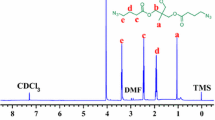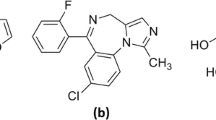Abstract
Molecular imprinting materials can successfully improve the efficacy and safety of drugs, thus showing good potential in the field of drug delivery. However, some difficulties in imprinted materials, such as the deep embedding of imprinting sites and poor accessibility, limit their application. Herein, we have developed porous designed molecularly imprinted polymers (MIPs) based on cleavage hyperbranched polymers for thiamine hydrochloride controlled release. By introducing hyperbranched polymers with terminal double bonds and sensitive disulfide bonds, the resulting porous MIPs (PMIPs) can expose more effective recognition sites and improve the drug-controlled release behavior, where significantly improved the drug loading (101.25 mg g−1) compared with the porous non-imprinted polymers (PNIPs, 16.57 mg g−1). Moreover, under the optimized conditions of pH 1.7 and 25 °C, the whole drug release time was increased from 16 h (PNIPs) to 32 h (PMIPs). As a result, this porous structure of MIPs designed approach provides an insight to fabricating improved imprinted constituents with higher adsorption capacity and faster recognition kinetics, which not only inspires more brilliant work in the future but also paves the way for the application of MIPs in the field of drug delivery.
Graphical abstract









Similar content being viewed by others
References
Song G, Cheng L, Chao Y, Yang K, Liu Z (2017) Emerging nanotechnology and advanced materials for cancer radiation therapy. Adv Mater 29:1700996
Chen Y, Fan ZX, Zhang ZC, Niu WX, Li CL, Yang NL, Chen B, Zhang H (2018) Two-dimensional metal nanomaterials: synthesis, properties, and applications. Chem Rev 118:6409–6455
Nuria RV, Stephan S, Luis FS, Manuel A, Juan RG (2013) Synthesis of cyclic γ-amino acids for foldamers and peptide nanotubes. Eur J Org Chem 2013:3477–3493
Ramasamy T, Ruttala HB, Gupta B, Poudel BK, Choi HG, Yong CS, Kim JO (2017) Smart chemistry-based nanosized drug delivery systems for systemic applications: a comprehensive review. J Control Release 258:226–253
Hu Q, Bu YS, Zhen XY, Xu K, Ke RF, Xie XY, Wang SC (2019) Magnetic carbon nanotubes camouflaged with cell membrane as a drug discovery platform for selective extraction of bioactive compounds from natural products. Chem Eng J 364:269–279
Bourquin J, Milosevic A, Hauser D, Lehner R, Blank F, Petri-Fink A, Rothen-Rutishauser B (2018) Biodistribution, clearance, and long-term fate of clinically relevant nanomaterials. Adv Mater 30:1704307
Gai SL, Yang GX, Yang PP, He F, Lin J, Jin DY, Xing BG (2018) Recent advances in functional nanomaterials for light-triggered cancer therapy. Nano Today 19:146–187
Nerantzaki M, Michel A, Petit L, Garnier M, Menager C, Griffete N (2022) Biotinylated magnetic molecularly imprinted polymer nanoparticles for cancer cell targeting and controlled drug delivery. Chem Commun 58:5642–5645
Lu HF, Xu SX, Guo ZC, Zhao MH, Liu Z (2021) Redox-responsive molecularly imprinted nanoparticles for targeted intracellular delivery of protein toward cancer therapy. ACS Nano 15:18214–18225
Chen FF, Wang JY, Chen HR, Lu RC, Xie XY (2018) Microwave-assisted RAFT polymerization of well-constructed magnetic surface molecularly imprinted polymers for specific recognition of benzimidazole residues. Appl Surf Sci 435:247–255
Corman ME, Cetinkaya A, Ozcelikay G, Ozgur E, Atici EB, Uzun L, Ozkan SA (2021) A porous molecularly imprinted nanofilm for selective and sensitive sensing of an anticancer drug ruxolitinib. Anal Chim Acta 1187:339143
Tuwahatu CA, Yeung CC, Lam YW, Roy VAL (2018) The molecularly imprinted polymer essentials: curation of anticancer, ophthalmic, and projected gene therapy drug delivery systems. J Control Release 287:24–34
Hua YB, Kukkar D, Brown RJC, Kim KH (2022) Recent advances in the synthesis of and sensing applications for metal-organic framework-molecularly imprinted polymer (MOF-MIP) composites. Crit Rev Environ Sci Technol. https://doi.org/10.1080/10643389.2022.2050161
BelBruno JJ (2019) Molecularly imprinted polymers. Chem Rev 119:94–119
Haupt K, Rangel PXM, Tse Sum Bui B (2020) Molecularly imprinted polymers: antibody mimics for bioimaging and therapy. Chem Rev 120:9554–9582
Janczura M, Luliński P, Sobiech M (2021) Imprinting technology for effective sorbent fabrication: current state-of-art and future prospects. Materials 14:1850
Song ZH, Li JH, Lu WH, Li BW, Yang GQ, Bi Y, Arabi M, Wang XY, Ma JP, Chen LX (2022) Molecularly imprinted polymers based materials and their applications in chromatographic and electrophoretic separations. TrAC Trend Anal Chem 146:116504
Liu R, Poma A (2021) Advances in molecularly imprinted polymers as drug delivery systems. Molecules 26:3589
Torabi SJ, Mohebali A, Abdouss M, Shakiba M, Abdouss H, Ramakrishna S, Teo YS, Jafari I, Ghomi ER (2021) Synthesis and characterization of a novel molecularly imprinted polymer for the controlled release of rivastigmine tartrate. Mater Sci Eng C Mater Biol Appl 128:112273
Schirhagl R (2014) Bioapplications for molecularly imprinted polymers. Anal Chem 86:250–261
Jia M, Yang J, Zhao YX, Liu ZS, Aisa HA (2017) A strategy of improving the imprinting effect of molecularly imprinted polymer: effect of heterogeneous macromolecule crowding. Talanta 175:488–494
Chen FF, Chen H, Duan X, Jia JQ, Kong J (2016) Molecularly imprinted polymers synthesized using reduction-cleavable hyperbranched polymers for doxorubicin hydrochloride with enhanced loading properties and controlled release. J Mater Sci 51:9367–9383. https://doi.org/10.1007/s10853-016-0183-2
Chen H, Kong J, Tian W, Fan XD (2012) Intramolecular cyclization in (A2) + (B3) polymers via step-wise polymerization resulting in a highly branched topology: quantitative determination of cycles by combined NMR and SEC analytics. Macromolecules 45:6185–6195
Schuell C, Frey H (2013) Grafting of hyperbranched polymers: from unusual complex polymer topologies to multivalent surface functionalization. Polymer 54:5443–5455
Smeets NMB (2013) Amphiphilic hyperbranched polymers from the copolymerization of a vinyl and divinyl monomer: the potential of catalytic chain transfer polymerization. Eur Polym J 49:2528–2544
Guo M, Wang R, Jin ZC, Zhang XY, Jokerst JV, Sun YT, Sun LP (2022) Hyperbranched molecularly imprinted photoactive polymers and its detection of tetracycline antibiotics. ACS Appl Polym Mater 4:1234–1242
Kaur K, Jindal R, Jindal D (2020) Controlled release of vitamin B-1 and evaluation of biodegradation studies of chitosan and gelatin based hydrogels. Int J Biol Macromol 146:987–999
Fathima SJ, Fathima I, Abhishek V, Khanum F (2016) Phosphatidylcholine, an edible carrier for nanoencapsulation of unstable thiamine. Food Chem 197:562–570
Allahkarami E, Dehghan Monfared A, Silva LFO, Dotto GL (2022) Lead ferrite-activated carbon magnetic composite for efficient removal of phenol from aqueous solutions: synthesis, characterization, and adsorption studies. Sci Rep 12:10718
Franco DSP, Pinto D, Georgin J, Netto MS, Foletto EL, Manera C, Godinho M, Silva LFO, Dotto GL (2022) Conversion of Erythrina speciosa pods to porous adsorbent for Ibuprofen removal. J Environ Chem Eng 10:108070
Hong CY, You YZ, Wu DC, Liu Y, Pan CY (2007) Thermal control over the topology of cleavable polymers: from linear to hyperbranched structures. J Am Chem Soc 129:5354–5355
Bu YS, Hu Q, Zhang XL, Li T, Xie XY, Wang SC (2020) A novel cell membrane-cloaked magnetic nanogripper with enhanced stability for drug discovery. Biomater Sci 8:673–681
Chen FF, Wang JY, Lu RC, Chen HR, Xie XY (2018) Fast and high-efficiency magnetic surface imprinting based on microwave-accelerated reversible addition fragmentation chain transfer polymerization for the selective extraction of estrogen residues in milk. J Chromatogr A 1562:19–26
Hu Q, Bu YS, Cao RQ, Zhang G, Xie XY, Wang SC (2019) Stability designs of cell membrane cloaked magnetic carbon nanotubes for improved life span in screening drug leads. Anal Chem 91:13062–13070
Xie XY, Hu Q, Ke RF, Zhen XY, Bu YS, Wang SC (2019) Facile preparation of photonic and magnetic dual responsive protein imprinted nanomaterial for specific recognition of bovine hemoglobin. Chem Eng J 371:130–137
Chen FF, Mao M, Wang JY, Liu JW, Li F (2020) A dual-step immobilization/imprinting approach to prepare magnetic molecular imprinted polymers for selective removal of human serum albumin. Talanta 209:120509
Hao Y, Gao RX, Liu DC, Tang YH, Guo ZJ (2015) Selective extraction of gallic acid in pomegranate rind using surface imprinting polymers over magnetic carbon nanotubes. Anal Bioanal Chem 407:7681–7690
Ruela ALM, Figueiredo EC, Pereira GR (2014) Molecularly imprinted polymers as nicotine transdermal delivery systems. Chem Eng J 248:1–8
Acknowledgements
This work was supported by the Natural Science Foundation of Shaanxi Province (No. 2017JQ2004).
Author information
Authors and Affiliations
Corresponding author
Ethics declarations
Conflict of interest
The authors declare that they have no known competing financial interests or personal relationships that could have appeared to influence the work reported in this paper.
Additional information
Handling Editor: Annela M. Seddon.
Publisher's Note
Springer Nature remains neutral with regard to jurisdictional claims in published maps and institutional affiliations.
Supplementary Information
Below is the link to the electronic supplementary material.
Rights and permissions
Springer Nature or its licensor (e.g. a society or other partner) holds exclusive rights to this article under a publishing agreement with the author(s) or other rightsholder(s); author self-archiving of the accepted manuscript version of this article is solely governed by the terms of such publishing agreement and applicable law.
About this article
Cite this article
Luo, L., Lv, C., Xing, Y. et al. Porous design of molecularly imprinted polymers for improved drug loading and organized release properties. J Mater Sci 58, 383–396 (2023). https://doi.org/10.1007/s10853-022-08049-z
Received:
Accepted:
Published:
Issue Date:
DOI: https://doi.org/10.1007/s10853-022-08049-z




